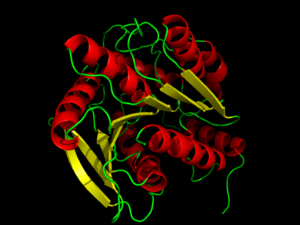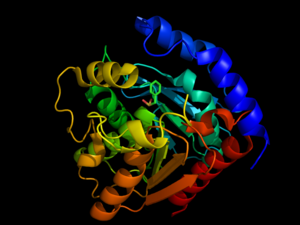Sandbox reserved 919
From Proteopedia
(Difference between revisions)
| Line 25: | Line 25: | ||
Hormone-sensitive lipase can be inhibited by phenylmethylsufonyl flouride ([http://en.wikipedia.org/wiki/PMSF PMSF]) covalently bound to the <scene name='58/580296/Meshligand/2'>active site</scene>. The experiments performed to test this inhibition used different strains of bacteria, which had a different order of residues but the same catalytic effect. This experiment tested the catalytic serine residue rather than the Ser157 residue seen in other HSL proteins. PMSF inhibits hydrolase by binding to the catalytic serine residue of the [http://proteopedia.org/wiki/index.php/Serine_Proteases serine protease] active site which disrupts the nucleophilic activity of the catalytic serine.<ref name="Kim">PMID: 19715665 </ref> This inhibitor will only bind to the active site Ser144 because of its participation in the charge relay of the <scene name='58/580296/Meshligandinteraction/1'>catalytic triad</scene>. This hyper activity allows the sulfonyl group of PMSF to <scene name='58/580296/Inhibitorinteraction/4'>covalently bond</scene> to the catalytic serine residue to disrupt its activity. Because of this catalytic serine residue specificity, PMSF does not inhibit all kinds of lipases, lipases such as pancreatic lipase and lipolase will not be inhibited by PMSF.<ref name="Kanwar">PMID:23923547</ref> PMSF is highly degradable in aqueous solutions so it does not inhibit for very long periods of time in its natural environment. PMSF binding induces only a minor conformational change from the native protein.<ref name="Kanwar"> | Hormone-sensitive lipase can be inhibited by phenylmethylsufonyl flouride ([http://en.wikipedia.org/wiki/PMSF PMSF]) covalently bound to the <scene name='58/580296/Meshligand/2'>active site</scene>. The experiments performed to test this inhibition used different strains of bacteria, which had a different order of residues but the same catalytic effect. This experiment tested the catalytic serine residue rather than the Ser157 residue seen in other HSL proteins. PMSF inhibits hydrolase by binding to the catalytic serine residue of the [http://proteopedia.org/wiki/index.php/Serine_Proteases serine protease] active site which disrupts the nucleophilic activity of the catalytic serine.<ref name="Kim">PMID: 19715665 </ref> This inhibitor will only bind to the active site Ser144 because of its participation in the charge relay of the <scene name='58/580296/Meshligandinteraction/1'>catalytic triad</scene>. This hyper activity allows the sulfonyl group of PMSF to <scene name='58/580296/Inhibitorinteraction/4'>covalently bond</scene> to the catalytic serine residue to disrupt its activity. Because of this catalytic serine residue specificity, PMSF does not inhibit all kinds of lipases, lipases such as pancreatic lipase and lipolase will not be inhibited by PMSF.<ref name="Kanwar">PMID:23923547</ref> PMSF is highly degradable in aqueous solutions so it does not inhibit for very long periods of time in its natural environment. PMSF binding induces only a minor conformational change from the native protein.<ref name="Kanwar"> | ||
| - | + | Lack of regulation or increased activity of hormone-sensitive lipases can possibly lead to disorders such as atherosclerosis, obesity, and type 2 diabetes. Increased concentration of free fatty acids (FFA) in skeletal muscles has been reported in many cases of obesity and type 2 diabetes. Inability to regulate or insufficient inhibition of HSL by PMSF could, in theory, also be a possible cause of these diseases. | |
</StructureSection> | </StructureSection> | ||
Revision as of 17:37, 21 April 2014
| |||||||||||
Additional pages about hormone-sensitive lipase
References
- ↑ 1.0 1.1 Holm C. Molecular mechanisms regulating hormone-sensitive lipase and lipolysis. Biochem Soc Trans. 2003 Dec;31(Pt 6):1120-4. PMID:14641008 doi:http://dx.doi.org/10.1042/
- ↑ 2.0 2.1 Ray H, Beylot M, Arner P, Larrouy D, Langin D, Holm C, Large V. The presence of a catalytically inactive form of hormone-sensitive lipase is associated with decreased lipolysis in abdominal subcutaneous adipose tissue of obese subjects. Diabetes. 2003 Jun;52(6):1417-22. PMID:12765952
- ↑ 3.0 3.1 3.2 3.3 Yeaman SJ. Hormone-sensitive lipase--new roles for an old enzyme. Biochem J. 2004 Apr 1;379(Pt 1):11-22. PMID:14725507 doi:http://dx.doi.org/10.1042/BJ20031811
- ↑ 4.0 4.1 4.2 4.3 Nam KH, Kim MY, Kim SJ, Priyadarshi A, Kwon ST, Koo BS, Yoon SH, Hwang KY. Structural and functional analysis of a novel hormone-sensitive lipase from a metagenome library. Proteins. 2009 Mar;74(4):1036-40. PMID:19089974 doi:http://dx.doi.org/10.1002/prot.22313
- ↑ Nam KH, Kim SJ, Priyadarshi A, Kim HS, Hwang KY. The crystal structure of an HSL-homolog EstE5 complex with PMSF reveals a unique configuration that inhibits the nucleophile Ser144 in catalytic triads. Biochem Biophys Res Commun. 2009 Nov 13;389(2):247-50. Epub 2009 Aug 26. PMID:19715665 doi:10.1016/j.bbrc.2009.08.123
- ↑ 6.0 6.1 Kanwar SS, Kaushal RK, Jawed A, Gupta R, Chimni SS. Methods for inhibition of residual lipase activity in colorimetric assay: a comparative study. Indian J Biochem Biophys. 2005 Aug;42(4):233-7. PMID:23923547


